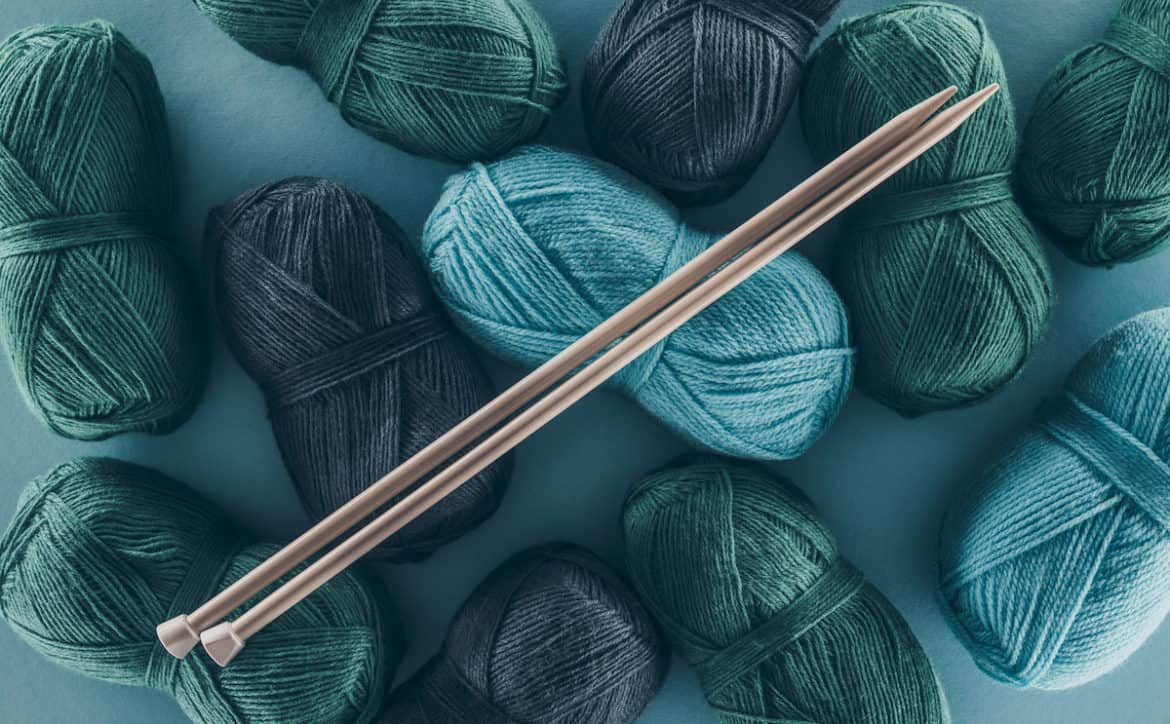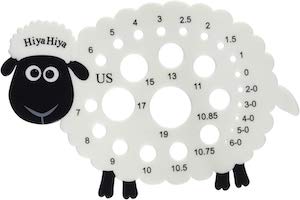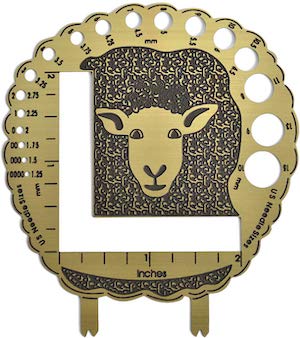One of the first things you need to become familiar with when you first start out with knitting is the size of the needle you need to use. As a result, we need an accurate method of measuring the needles in the first place.
Even if you are already proficient in the world of knitting, it’s possible that you aren’t using – or haven’t even heard of – a knitting needle gauge.
These knitting needle gauges are super important since they’ll allow you to find out the size of your needle even if it doesn’t have the numbers on it.
So what are the best needle gauges? The 3 best knitting needle gauges are the Susan Bates Knitchek, the HiyaHiya knitting needle gauge, and The Elegant Knitter sheep brass knitting needle. I’ll go into the reasons why these are the best needle gauges later on in the article, covering each in-depth.
In this guide we’re not only going to discuss the best gauges, but also why it’s important to use them. We’ll take a look at the 3 best knitting needle gauges so that you can make an informed decision before you take the plunge and spend your hard-earned cash.
Before any of that though, I think it’s worth explaining a little bit about what exactly a knitting needle gauge is, so you can better understand what we’re talking about.
What Is a Knitting Needle Gauge?
A knitting needle gauge refers to the flat measuring tool used to ascertain the size of a knitting needle.
Essentially an odd-shaped ruler with a number of holes in it, you use the knitting needle gauge by inserting your needle into the hole it corresponds to, and reading the number next to that hole.
Particular needles, for example circular and double-pointed needles can sometimes lack the size information on the needle itself. That’s where the knitting needle gauge comes in. You just take it out, and immediately find out what size needle you’re working with, so you can see if it’s the best fit for the specific project you are working on.
It’s important to get an accurate reading of your knitting needle, so if there is extra space when you put the needle through one hole, you should try placing it through the next biggest hole.
The knitting gauge also works on crochet hooks, which makes it even more handy to have around!
Finally, the last thing you should know about knitting needle gauges is that they come in all kinds of fun shapes and patterns. While this isn’t the most important thing about them, it can certainly add a splash of personality to your knitting kit.
The 3 Best Knitting Needle Gauges
Now that you know what a knitting needle gauge is, and what it’s used for, I’d like to show you the 3 best out there right now. This will make your life much easier when it comes to parting with your cash!
1. Susan Bates 14099 Knit-Check for Knitting Needle
Check current price on Amazon.
One if the best in the business, this knitting needle gauge from Susan Bates is the only gauge you’ll ever need.
Clearly indicating both the stitch and row gauge for every size of needle, you’ll be able to easily find out the size of your needle and it’s suitability for your current project.
This product is also very compact, making it the perfect travel companion, should you wish to take your knitting on holiday with you.
Made from metal, this needle gauge won’t break on you, and won’t bend easily like plastic ones can.
2. HiyaHiya Knitting Needle Gauge Sheep
Check current price on Amazon.
Whereas the first option is a safe and sturdy one, this next one leans more towards the playful side, making it perfect for anyone wanting to add some character to their knitting supplies.
Made in the appearance of a jolly, rotund sheep, the design of this knitting needle gauge alone might be enough to warrant the purchase.
Aesthetics aside, this plastic knitting gauge has a wide variety of holes, so you can identify all of your unlabeled needles effortlessly.
As a nice additional feature, you can read the needle sizes in millimeters too, catering for those more familiar with the metric system.
3. The Elegant Knitter Sheep Brass Knitting Needle Gauge
Check current price on Amazon.
In keeping with the sheep theme, this offering from The Elegant Knitter is for the more discerning, or elegant, knitter.
A premium option, this needle knitting gauge is for those who value the nicer things in life, even when it comes to knitting. It’s nice to treat yourself every now and again and get something a bit flashier, and I personally think this sheep-inspired needle gauge is a great such purchase.
Made of solid brass, this circular needle gauge will add some joy to the typically mundane process of measuring your needles.
The etched sheep motif can watch over you as you knit your latest warm winter sweater, serving as a reminder of who you should be grateful to for providing the great quality wool.
Measuring both USA and metric systems, you can use this needle gauge wherever in the world you are, and whichever measuring system you’re accustomed to.
How to Use A Knitting Needle Gauge
In order to get the most out of your knitting projects, you’d certainly benefit from using the right size needle for the job.
Yarn will often come with some guidelines as to the best size needle to use to make whatever it may be. This can depend on the number of stitches per inch for example, as well as a few other factors.
So this means you should be looking to use your knitting needle gauge in combination with the instructions of the yarn that you’ll be working with to ascertain the best size needle for the job.
You might also find it useful to take your knitting needle gauge with you wherever you plan on doing some knitting. Say you’re spending the afternoon with some friends knitting Christmas gifts, then it’s worth bringing your gauge so you can measure any unmarked needles you might want to use if you don’t bring your own.
Related Questions
What is a gauge swatch ruler?
Another useful tool to add to your knitting kit would be a gauge swatch ruler. While some knitting needle gauges come with this ruler, others don’t, so you might have to buy one separately.
So what exactly is the gauge swatch ruler, and why do you need one?
The gauge ruler is used to measure your gauge swatch. A gauge swatch is a 4×4 inch patch that you can knit for reference purposes and other reasons. With this ruler, you can accurately count the amount of stitches in the swatch, and take accurate measurements.
This makes it an incredibly useful measuring tool for your stitch work, equally the importance of the knitting needle gauges for needles.
Why is needle size important?
The whole idea of using the knitting needle gauge is to figure out what size needle you are working with. But why do we need to know the size of the needle in the first place, and how can it help with our knitting?
The size of the needle in knitting affects the size of your stitches. As a result, you can decide in advance which needle you’re going to need, based on whether you want to work with large and loose or small and tight stitches.
The bigger the needle, the bigger the gauge will be. If you find out what gauge you need for your specific project – based on the guidelines of the yarn you want to use – then you can use the right needle for the task.
This is partly why swatches exist in knitting. As we mentioned earlier, a swatch is a small patch of knitting that can give you information about stitch count, and allow you to practice knitting with various gauges, etc. They can also help you figure out what gauge or size needle you should opt for.
What can happen if you use the wrong size needle?
The size of the needle you should use according to the yarn you’re working with is only a recommendation. This means that it’s advised, but not obligatory for a successful knitting project.
However, it is always worth paying attention too, since some projects require a specific gauge. If you knit a sweater with the wrong gauge for example, it can end up being far too tight, or far too loose and large.
So while it’s probably fine to use a size needle one above or below the recommended number, I wouldn’t try and go too far away from that. Otherwise, you could end up with a less than satisfactory end product, which needless to say can be avoided.



